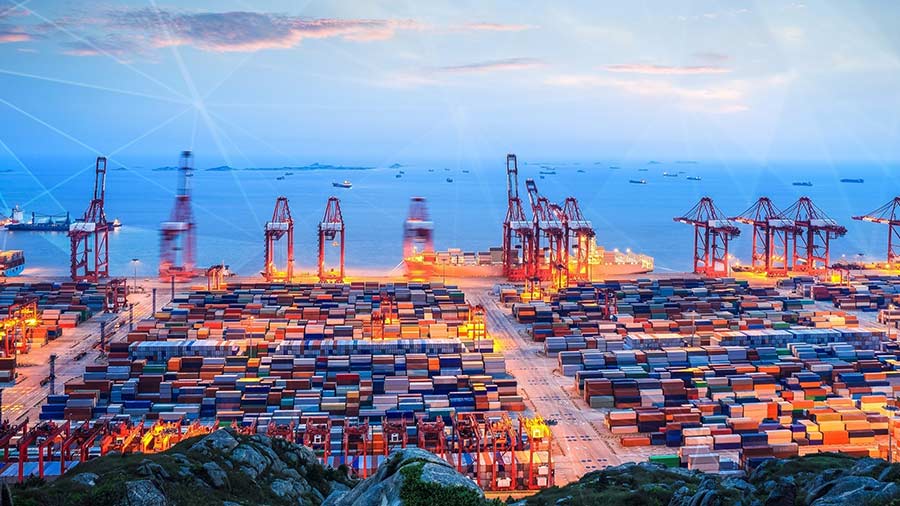The ASEAN Smart Logistics Network: An Overview

The ASEAN Smart Logistics Network (ASLN) is a platform that aims to promote logistics interconnectivity and integration within the ASEAN bloc.
In addition to improving connectivity among the 10-member grouping, the ASLN seeks to promote the use of smart and sustainable logistics infrastructure. It supports the ASEAN Connectivity Master Plan 2025, which is a policy promoting integration between ASEAN members.
The ASLN was launched in November 2020 with the first project being the development of the Vinh Phuc Inland Container Depot Logistics Centre (Super Port) between Singapore and Vietnam.
A year on, we look at what progress has been made and what opportunities it could bring for foreign investors in the region.
The ASEAN Smart Logistics Network in practice
So far, two projects have been launched under the ASLN: one in Vietnam, and one in Cambodia. These projects offer a window into what the ASLN looks like in practice. Details are as follows.
The Vinh Phuc ICD Logistics Center
The first project under the ASLN is the Vinh Phuc ICD Logistics Center, located in the northern Vietnamese province of Vinh Phuc. Vietnam and Singapore jointly launched it in November 2020 at an event attended by the prime ministers of both countries.
The project will see the development of an inland container depot and logistics center in Vinh Phuc, which planners dub a “Super Port”. Upon completion, it will be one of the largest logistics centers in North Vietnam, connecting 20 industrial parks by rail, roads, and air, as well as linkages with Hanoi, Hai Phong International Airport, and China’s Yunnan province.
The project is managed by Vietnam’s T&T Group and Singapore’s YCH Group and has over US$166 million in funding.
Phnom Penh Logistics Complex
In March 2021, Cambodia’s Ministry of Public Works and Transport and Singapore’s YCH Group released a framework agreement to develop the Phnom Penh Logistics Complex in Cambodia. The agreement makes it the second project to launch under the ASLN.
According to the agreement, the Phnom Penh Logistics Complex is designed to be a “modern, world-class” logistics complex, using logistics technology to improve resilience, visibility, and logistics process flow. It will also feature a training academy and startup hub to train Cambodia’s human capital in the logistics sector.
Like the project in Vietnam, the Phnom Penh Logistics Complex aims to follow YCH Group’s “SuperPort” concept. The project carries an estimated cost of US$200 million and will begin in earnest in 2022.
Implications for foreign investors
The first two projects under the ASLN may reveal trends about future projects, and how foreign investors may benefit from them.
Notably, both projects involve Singapore’s YCH Group leading the development of logistics infrastructure in less-developed host countries. While it is unlikely that all ASLN projects will include YCH Group, it may be the case that other projects will see companies with the experience, expertise, and resources in more developed markets lead projects alongside local partners in host countries.
Although the main entities in ASLN projects will be ASEAN-based, foreign companies may be involved through providing consulting services, goods and services used for infrastructure development, and other forms of collaboration. Further, foreign investors may emerge as key funders of ASLN projects.
Foreign businesses active in the ASEAN region also stand to benefit from the results of the projects, even if they are not directly involved. Given the severe infrastructure deficits in many ASEAN countries, greater regional integration will lead to cheaper, faster, and more efficient logistics, benefiting trade in goods and services across the region.
Contributing to the ASEAN Connectivity Master Plan 2025
The goal of the ASLN is to advance the logistics priorities stated in the ASEAN Connectivity Master Plan 2025. Logistics is just one area in the Master Plan, which also focuses on sustainable infrastructure, digital innovation, regulatory excellence, and people mobility, among other areas.
Regarding logistics, the Master Plan states two strategic objectives: lower supply chain costs in each ASEAN Member State and improve speed and reliability of supply chains in each ASEAN Member State.
In pursuit of these two strategic objectives, the Master Plan contains two initiatives, these are:
- Strengthening ASEAN competitiveness through enhanced trade routes and logistics; and
- Enhancing supply chain efficiency through addressing key chokepoints.
Logistics priorities also feed into other goals in the Master Plan, including building soft infrastructure to support the efficiency of infrastructure usage, supporting the development of e-commerce, and providing objective measures of progress and bottlenecks.
The Master Plan notes, however, that previous initiatives to improve logistics in ASEAN have not advanced as quickly as envisioned. According to the Master Plan, this is because of a lack of coordination between government departments and sharing of best practices.
In light of these challenges, the Master Plan notes that there is an opportunity to create mechanisms to support greater collaboration between logistics firms, academic institutions, and the ASEAN Member States as a means to identify bottlenecks across key areas of the region’s supply chains.
Source : aseanbriefing.com



